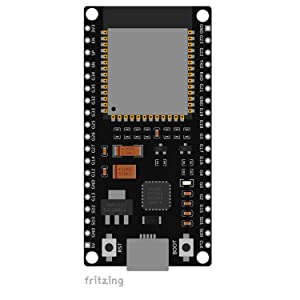Description
The AZ-Delivery Dev Kit C was designed by Espressif to provide an easy introduction to programming the new ESP32 dual-core processor. With a variety of new sensors and functions, this board represents the next step in IoT development.

Special features
- As with the predecessor model ESP8266, the WLAN functionality is implemented directly in the SoC, but with additional Bluetooth function (incl. BLE).
- The ESP32 processor used combines a CPU with 2 Tensilica LX6 cores, clocked at up to 240 MHz, and 512 kilobytes of SRAM in a single microcontroller chip.
- It also integrates a radio unit for WLAN (according to 802.11bgn) and Bluetooth (Classic and LE).
Technical specifications
| Power supply voltage (USB) | 5V |
| Input/output voltage | 3.3V |
| Required operating current | Min. 500mA |
| Soc | ESP32-Wroom 32 |
| Clock frequency range | 80 MHz / 240MHz |
| R.A.M. | 512kb |
| External flash memory | 4MB |
| I/o pins | 34 |
| Interfaces | SPI, I2C, I2S, Can, Uart |
| Wi-fi protocols | 802.11 b/g/n (802.11n up to 150 Mbps) |
| Wi-Fi frequency | 2.4 GHz - 2.5 GHz |
| Bluetooth | V4.2 - BLE and Classic Bluetooth |
| Wireless antenna | PCB |
| Dimensions | 56x28x13mm |

Digital and GPIO pins
The 32 pins provide UART, I2C, SPI, DAC, ADC (12 bit) and all GPIO pins can be used as an input or output.

Quick start guide
When buying one of our high-quality products, you will also receive an inclusive e-book for a quick introduction to the world of microelectronics.







